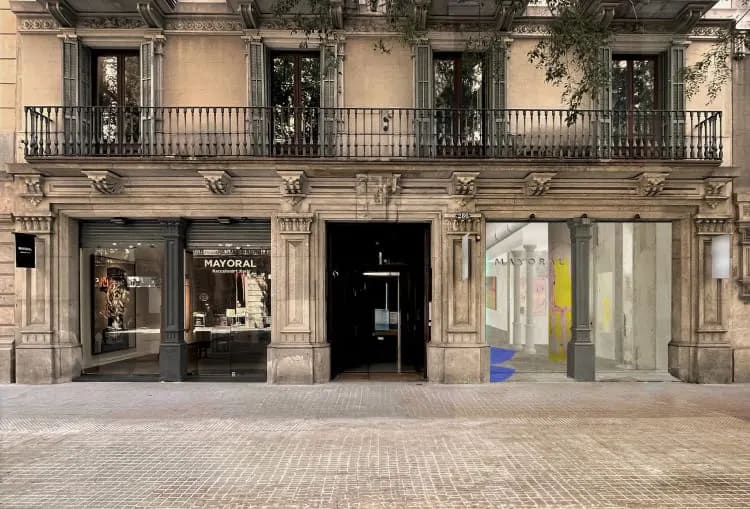ALEXANDER CALDER AND JOAN MIRÓ: A FRIENDSHIP, A COMPLICITY
Joan Punyet Miró
Calder and Miró first met in Paris in late December 1928, following the suggestion made to Calder by a fashion designer named Elizabeth Hawes in New York. On 10th December, Calder sent Miró a short handwritten note in French, which ended with the exclamation: “And I hope you can make this out!” showing how keen he was that Miró should understand the message.
“Someone in New York, a girl named Elizabeth Hawes, had told me to look up Joan Miró, so I went up to Montmartre to see him. He lived in a sort of metal tunnel, a kind of Quonset hut. He was very affable and showed me one or two of his things, the rest having been sent to Brussels for a show.”
[i] Calder was probably referring to the exhibition that opened on 11
th May at the Galerie Le Centaure in Brussels.
One of the works that remained behind in the studio in the Rue Tourlaque, where Miró had temporarily installed himself, was a collage entitled
Spanish Dancer, the result of combining a feather, a cork and a needle on a piece of cardboard. “I was nonplussed,”
[ii] commented Calder when describing the impression made by the choice of such simple materials to achieve such a degree of suggestive lyricism.
“One of them was a big sheet of thick grey cardboard with a feather, a cork and a picture postcard glued to it; […] it did not look like art to me,” he wrote, recalling the combination of objects carefully selected to form an avant-garde lexicon that tried to achieve the maximum expression with the minimum number of components. It is important to remember Miró’s interest in going beyond formalist painting, as he himself declared to the art critic Tériade: “Painting has been in decline since the days of the cavemen.”
During this period Calder earned the sympathy of art critics, gallery owners and artists as a result of the many performances of his travelling miniature circus. It should be noted that, at that time, the circus was the most popular attraction and there were critics who specialised in the subject. Thanks to his astonishing skill with wire and cloth and his savoir-faire as an engineer, Calder possessed the necessary ability to create complicated working contraptions that held the audience spellbound.
The sculptor Isamu Nogucho described how “I had been involved in Sandy’s circus in Paris from the every beginning when he started to get together the various characters: Master of Ceremonies, sword swallower, hoochie coochie dancers, Japanese jugglers. And he had more or less put me in charge of the crank-up phonograph mainly with the record ‘Ramona’ (Belle brune de Barcelone, tes baisers me donnent des frissons d’amour).”
Calder had by then already produced a number of wire sculptures such as The Brass Family, which involved the entirely innovative concept of giving new life to forms that cohabited freely in space without any canvas, stretchers or other previously known support.
Miró, five years older than Calder, was already considered “the most surrealist painter of all of us”, in the words of André Breton in his (then) recent publication Le Surréalisme et la peinture. In May 1928, Pierre Loeb put on a one-man show of Miró’s work at the Galerie Georges Bernheim & Cie., which was a total success from both the critical and the commercial points of view. Shortly after it opened, Miró travelled to Belgium and Holland before returning briefly to Paris and then going to Mont-roig, where he produced the series of three Dutch interiors based on postcards of seventeenth-century Dutch interiors that he had purchased at the Rijksmuseum in Amsterdam. In early December he returned to Paris with his paintings, with the aim of sending them to Brussels as soon as possible for his next exhibition, and it was precisely at this point that the paths of Miró and Calder crossed.
Sean Sweeney, son of James Johnson Sweeney, remembered Miró and Calder as “very different people: Miró was shy, an interior person. He was always beautifully dressed with very nice suits. I would say that he had a very formal appearance in a way, and this for me belied what was underneath. He seemed to be conservative in his outer looks, but when his painting came out he was an iconoclastic poet and not conservative in any way. He was a very free poet and creator.” As for Calder, “He appeared to the people wearing jeans, a red shirt, boots or practical shoes. At openings, when everybody was dressed up for the occasion, he would appear as always, in his black jeans and his red shirt. However, underneath he was equally a poet with wire and metal. […] However I wouldn’t say that one influenced the other, since Miró did what he wanted to do, and they appreciated one another because they were soul mates.”
Sandra Davidson, Calder’s eldest daughter, was born on 20th April, the same date as Miró, which brought the families together on their birthdays. Recalling the two men, Sandra says: “They were completely different people. My father was always outgoing and very noisy whereas Miró was contained and quiet.” These traits were always very marked in both artists although at no time did they constitute an obstacle to their friendship.
Even Miró’s wife, Pilar, had nostalgic and affectionate memories of Calder, whom she described as “an immensely grateful man who was very fond of Joan”.


